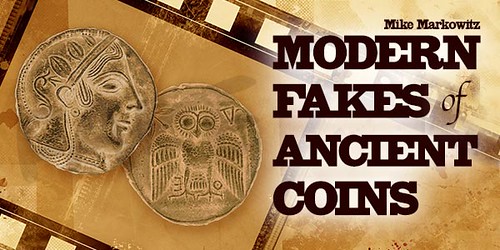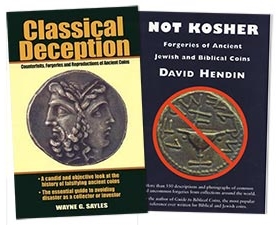
PREV ARTICLE
NEXT ARTICLE
FULL ISSUE
PREV FULL ISSUE
MODERN FAKES OF ANCIENT COINS
Now we move from fake errors to fake ancients.
This December 6, 2016 CoinWeek article by Mike Markowitz examines the topic of modern fakes of ancient coins.
He's one of my favorite writers, and I always learn something new from his articles. here's an excerpt.
-Editor

FOR CLASSICAL NUMISMATISTS any discussion of fake ancient coins is... a delicate subject. Dealers worry that fear of fakes will scare off potential collectors. Collectors worry that the prevalence of fakes could depress the value of their coins. In reality, most ancient fakes are not dangerous to an expert, or even to a well-informed beginner. In the eternal war between forger and authenticator, the good guys still hold the advantage. "Some people differentiate between the terms "counterfeit" and "forgery", using "counterfeit" to refer to fakes created to circulate and "forgery" to refer to fakes created to deceive collectors." --Reid Goldsborough Counterfeits are almost as old as coinage. Ancient counterfeits circulated widely in a world where small change was often in short supply. Whether, cast, struck or plated, such fakes are still ancient coins, and many are quite collectable today. Modern fakes, on the other hand, are usually worthless, unless they are precious metal with some melt value, or examples of the work of famous forgers of the Renaissance and early modern eras.
Becker Becker always insisted that his work was not intended to defraud collectors, but only to make great works of numismatic art available to collectors of modest means. In 1824, the Austrian Imperial Coin Cabinet in Vienna acquired Becker’s dies, and a detailed catalog of his work was published a century later (Hill, 1924). Becker fakes frequently appear (correctly attributed as fakes) in European auctions.
Peter Rosa In 1955 doing business as the “Becker Manufacturing Company” he began selling reproductions of ancient coins and Becker’s fakes. Over the course of three decades, he produced many hundreds of different coin dies; some 331 were acquired by the American Numismatic Society (ANS).
The artlcle also discusses some excellent books on the topic:
-Editor
To read the complete article, see:

Wayne Homren, Editor The Numismatic Bibliomania Society is a non-profit organization promoting numismatic literature. See our web site at coinbooks.org. To submit items for publication in The E-Sylum, write to the Editor at this address: whomren@gmail.com To subscribe go to: https://my.binhost.com/lists/listinfo/esylum All Rights Reserved. NBS Home Page Contact the NBS webmaster 
|
